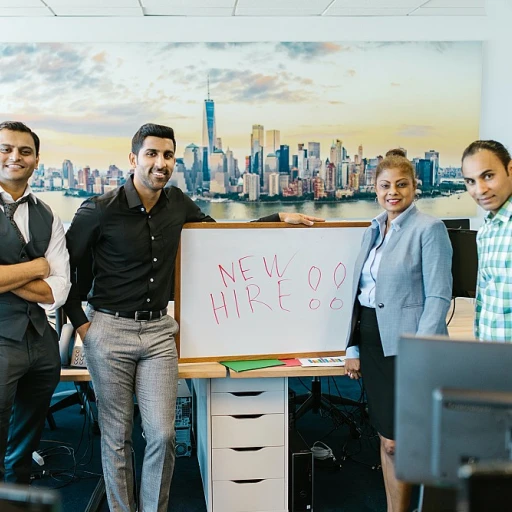The Forming Stage: Building Foundations
Starting Off: Crafting a Strong Foundation
Understanding the formative stage of team development is essential to establishing a solid foundation for any group endeavor. The Forming stage is the initial phase of Tuckman's model where team members begin their journey. At this point, members are often excited but unsure about their roles as they start working together on a new project. This stage is about breaking the ice, fostering an open line of communication, and setting mutual objectives.
During the Forming stage, team leaders should work diligently to establish a clear structure and provide guidance that will help team members grow in confidence and ability. This is an ideal time for implementing effective team-building activities that nurture interaction and collaboration. These activities can serve as a catalyst for building trust and promoting an environment that encourages idea exchange without the fear of judgment, thereby setting the groundwork for later stages.
Moreover, being proactive in conflict resolution even in these early stages will prevent potential disagreements from disrupting the team as it transitions into the Storming phase. The focus should be on clear communication and patience, as the team is likely composed of individuals with diverse backgrounds and work styles.
As team members gradually become more comfortable, leaders should actively promote inclusivity and a shared vision to steer the group towards Norming and Performing phases where cohesive teamwork and productivity can truly flourish. Laying such groundwork is vital for the overall process of team development, establishing a dynamic that aligns with the goals of high performance and engagement. As we explore each of Tuckman's stages further, it becomes clear how each phase builds upon the last to enhance team cohesion and productivity effectively.
Storming: Navigating Through Conflict
Navigating Challenges During Team Development
The Storming phase, within the framework of Tuckman's team development model, represents a challenging period that teams must navigate as they progress from forming to norming. During this stage, team members often experience heightened levels of conflict and competition as they begin to push against previously established boundaries. This is a critical period for group development, where the presence of diverse opinions and potential friction can lead to either fragmentation or strengthened collaboration. In this phase, teams can expect conflicts to arise over roles, responsibilities, and differing perspectives on the project. It becomes vital for the team leader to actively mediate these disagreements and guide the team towards constructive communication. This proactive engagement is crucial in directing the energy from disagreements towards innovative solutions and enhanced group cohesion. Understanding that conflict is a natural part of the team development process helps in demystifying the storming stage. It provides a framework through which team leaders can anticipate challenges, showing that these hurdles are stepping stones rather than roadblocks. Moreover, it underscores the importance of fostering an environment where members feel secure enough to express dissent while working towards common goals. As storming unfolds, team leaders play a pivotal role in maintaining momentum and steering the team towards the stabilization intended in subsequent stages. During this time, incorporating innovative approaches to team building becomes essential. These approaches can facilitate better understanding and collaboration among team members, further bridging the gap between discord and unity. For those seeking strategies to navigate this complex stage, exploring innovative approaches to team building can offer valuable insights. Such innovative strategies enhance the overall team dynamics, providing tools and techniques to bring the team closer to the performing stage, where productivity and collaboration reach their peak.Norming: Establishing Team Cohesion
Fostering Collaboration and Setting Norms
The norming stage in Bruce Tuckman’s model is pivotal for transforming a collection of individuals into a cohesive unit. This phase is characterized by the emergence of norms and standards that guide collective behavior and project management processes. During this time, team members start to establish roles and responsibilities, facilitating smoother group development. Team leaders play a crucial role in this stage, as they help teams navigate the transition from conflict to cohesion. By promoting open communication, they encourage members to express ideas and resolve former tensions from the storming phase constructively. This nurturing of collaboration promotes trust, enabling teams to work more effectively towards their shared goals. One of the remarkable outcomes of this stage is the development of a shared vision. Teams begin to align their personal objectives with the team's overall goals, creating synergy and engagement. Such alignment is vital for high-performing groups, as it leads to increased satisfaction and commitment among team members. Furthermore, recognizing and celebrating small wins during this phase is essential. Successes, no matter how minor, reinforce positive behavior and enhance motivation. Leaders should encourage regular feedback loops to fine-tune processes and acknowledge the contributions of every individual. This active reinforcement of team cohesion lays the groundwork for the subsequent phase, performing. Through effective implementation of the norming phase principles, organizations can significantly improve employee engagement. For further insights into boosting motivation throughout this process, you might find more strategies here.Performing: Achieving Peak Productivity
Reaching Peak Performance through Effective Collaboration
The performing stage of Bruce Tuckman's team development model is where teams begin to truly thrive and achieve their highest potential. At this juncture, the groundwork laid during the forming, storming, and norming stages begins to bear fruit. Members understand their roles clearly and collaborate efficiently, allowing for optimum productivity. During this stage, the team leader's role evolves into more of a facilitative position. Their focus shifts from resolving conflicts, as seen during the storming phase, to enhancing team autonomy. High-performing teams in this stage are typically more self-sufficient and require less direct supervision, as team members have developed trust and communication skills that guide group dynamics seamlessly. Key Elements of the Performing Stage:- Autonomy and Efficiency: Teams operate with a high level of independence, making decisions collectively and driving projects forward without excessive oversight.
- Strong Collaboration: Unified effort and collaboration characterize the working environment. Team members are adept at leveraging each other's strengths to achieve shared goals.
- Problem-solving and Innovation: Groups become adept at identifying and resolving issues swiftly. Creativity flourishes as members feel secure enough to propose innovative solutions.
Adjourning: Reflecting and Moving Forward
Reflecting on Team Experiences
The final phase of Bruce Tuckman's model, the adjourning stage, is crucial in the journey of team development. At this point, the group begins to reflect on their work and the experiences shared. It represents the conclusion of a project or team collaboration, where members take stock of what they have accomplished together and identify lessons learned for future endeavors. For team leaders, this stage is an opportunity to provide closure and address the emotional impacts of the team's transition. Celebrating the achievements and acknowledging each member's contributions help to solidify the bonds formed during the team's development stages. Here’s how the adjourning stage can aid in enhancing overall employee engagement:- Acknowledgment of Accomplishments: Recognizing the hard work and milestones achieved not only boosts morale but also reinforces a culture of appreciation within the organization.
- Feedback Sessions: Conducting a detailed review of the project by facilitating feedback sessions can help team members voice their opinions. This process encourages transparent communication and highlights areas for improvement.
- Skill Assessment: Reflecting on the team’s journey offers a chance to evaluate personal and collective skill growth. Identifying strengths and areas of development can guide future project allocations.
- Emotional Closure: Providing emotional closure ensures that team members feel connected and valued, even as they transition to new roles or projects.
Integrating Tuckman's Model in Employee Engagement Strategies
Integrating the Model into Employee Strategies
Understanding how to implement Tuckman's stages of team development effectively can significantly boost employee engagement. The process begins by recognizing where your team currently stands within the model. For instance, a new project team may be at the forming stage, where initial guidance and orientation are vital in setting the groundwork. As team leaders, being patient and open to questions can help members feel more comfortable and committed.
When the team progresses into the storming stage, conflicts might arise. This is a critical time to provide support and clear communication avenues. Incorporating conflict resolution training in your strategy can empower team members to navigate this stage productively.
As teams move into the norming stage, promoting open communication and shared goals can foster a cohesive environment where collaboration flourishes. Here, team development activities that align with personal and collective objectives can be beneficial. A management diploma in team dynamics can aid leaders in refining this process effectively.
During the performing stage, where productivity peaks, recognizing and rewarding high performance becomes essential. This not only helps sustain motivation but also reinforces a culture of excellence. Regular feedback and the opportunity for development should be part of the team's progression strategy.
Finally, in the adjourning stage, offering reflective sessions allows teams to evaluate successes and areas for improvement. This process can encourage continuous development and growth within individual and group dynamics.
Integrating these practices within the framework of Tuckman's model can greatly enhance how teams function and engage, ultimately leading to a more productive and satisfied workforce.












